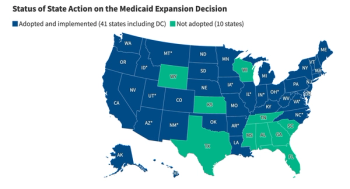
Out-of-Network Use 10 Times Higher for Psychological Care vs. Medical Care APA-Funded Study Finds
Psychiatrists and psychologists also had lower in-network reimbursement rates.
Mental healthcare is increasingly inaccessible, and more and more patients are going out-of-network to get help, the results of a new study from the nonprofit research organization Research Triangle Institute, shows.
The study, called Behavioral Health Parity – Pervasive Disparities in Access to In-Network Care Continue, was led by economists Tami L. Mark, Ph.D., MBA and William Parish, Ph.D. They used data from 2019 to 2021 from MarketScan,one of the largest commercial insurance claims databases, to see how often patients were using out-of-network providers. Results were
Mark and Parish found that patients were 10.6 times more likely to go out-of- network for psychological visits than to find specialty care (18.2% as compared to 1.7%).
They also found that of the 24 listed specialist types, (allergists, cardiologists and neurologists etc.), patients went out-of-network the most for psychiatric office visits.
In addition, patients went out-of-network for psychiatric treatment 19.9 times more often than for medical inpatient treatment.
Results were consistent between telebehavioral and telemedicine visits too.
“The findings of this report, while not surprising, are gravely disappointing,” said APA CEO Arthur C. Evans Jr., PhD. in a press release. “The fact that so many patients are forced to go out-of-network to receive mental health and substance use care is unacceptable.”
These findings contradict the goals of the Mental Health Parity and Addictions Equity Act (MHPAEA) of 2008 which aimed to end discriminatory health plan coverage that prevents patients from receiving affordable care. To do this, it requires health plans to not have financial requirements when it comes to addiction and mental health services.
Provider shortages do not explain this disparity either, a reason that is commonly cited. Data from the U.S. Health Resources and Services Administration shows that there are 25% more shortages in primary care physicians when compared to mental health providers, Mark and Parish write.
To close this gap and improve access, Mark and Parish recommend that health plans and states expand their behavioral health networks and increase reimbursement rates, so they are comparable to medical/surgical provider rates. They also suggest evaluating reimbursement rates by provider type and consider not only the average reimbursement but reimbursement by the 50th, 75th and 95th percentiles.
For medical/surgical clinical office visits at the 95th percentile, reimbursement was 70.4% higher than for behavioral health clinicians.
Newsletter
Get the latest industry news, event updates, and more from Managed healthcare Executive.





















































